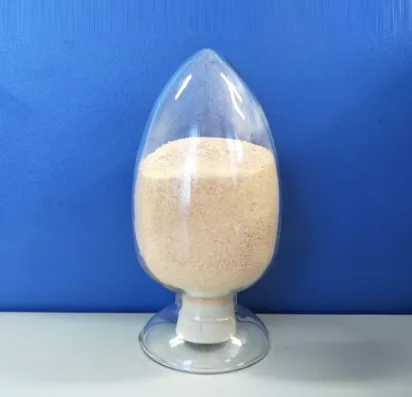
ਖ਼ਬਰਾਂ
ਮਈ . 09, 2025 11:47 ਸੂਚੀ 'ਤੇ ਵਾਪਸ ਜਾਓ
Polysuccinimide: A multifunctional biodegradable polymer
ਪੋਲੀਸੁਸੀਨਾਈਮਾਈਡ is a biodegradable polymer with unique structure and excellent properties, which has received widespread attention in recent years. It is a linear polyimide obtained by thermal polymerization or chemical synthesis of L-aspartic acid, and its molecular main chain is composed of repeated succinimide units. Polysuccinimide has a unique imide ring structure that endows it with various reactivity, allowing it to be modified through hydrolysis, amination, and other methods to obtain derivatives with different properties. This article will elaborate on the synthesis method, property characteristics, and application prospects of PSI from three aspects.

The synthesis methods of Polysuccinimide mainly include thermal polymerization and chemical synthesis
Thermal polymerization usually uses L-aspartic acid as the raw material and directly undergoes dehydration condensation reaction under high vacuum or inert atmosphere at high temperature conditions. The advantages of this method are simple operation and low cost, but there are problems such as wide product molecular weight distribution and poor structural control. Chemical synthesis usually involves activating the carboxyl group of L-aspartic acid, such as using a condensing agent or converting it into an active ester, and then reacting it with aspartic acid salts or free amino groups. The advantages of chemical synthesis methods are controllable product structure and adjustable molecular weight, but the reaction conditions are more demanding and the cost is higher.
Polysuccinimide itself is a hydrophobic and brittle polymer with poor solubility, which limits its direct application
However, PSI has a unique imide ring structure, which gives it strong reactivity. It can be modified through hydrolysis, amine hydrolysis, alcoholysis, and other methods to obtain a series of derivatives with different properties. For example, poly (aspartic acid) (PASP) can be obtained through hydrolysis. PASP is a polymer with good water solubility and biodegradability, widely used in water treatment, detergents, and agricultural water retaining agents. Various amino groups can be introduced through amine hydrolysis to obtain polymers with specific functions, such as amino modified ਪੋਲੀਸੁਸੀਨਾਈਮਾਈਡ, which can be used for drug delivery and gene transfection.
The application prospects of Polysuccinimide and its derivatives are very broad
Firstly, due to its excellent biodegradability and biocompatibility, Polysuccinimide and its derivatives have enormous potential in the field of biomedical materials, such as drug delivery systems, tissue engineering scaffolds, and medical adhesives. Secondly, Polysuccinimide and its derivatives also have important application value in the field of water treatment. PASP, as a natural polymer flocculant, can effectively remove suspended solids and heavy metal ions from water. In addition, Polysuccinimide and its derivatives can also play important roles in agriculture, cosmetics, food, and other fields, such as as as plant growth promoters, skin moisturizers, and food additives.
In summary, ਪੋਲੀਸੁਸੀਨਾਈਮਾਈਡ, as a biodegradable polymer with unique structure and excellent properties, has broad application prospects. With the continuous advancement of synthesis technology and innovation of modification methods, Polysuccinimide and its derivatives will play an increasingly important role in various fields. The future research focus should be on developing more efficient and economical synthesis methods, exploring more diverse modification strategies, and conducting in-depth studies on the performance and application mechanisms of Polysuccinimide and its derivatives in different application fields.
Polysuccinimide FAQs
What is Polysuccinimide?
Polysuccinimide is a high molecular weight polymer synthesized by condensation reaction of aspartic acid (or maleic anhydride with ammonia), which appears as a yellow to brown solid. It is a precursor of Polyaspartic Acid (PASP), which can be converted into water-soluble polyaspartic acid after hydrolysis and is widely used in environmental protection and industrial fields.
How is Polysuccinimide synthesized?
The main synthesis methods include:
Heat shrink polymerization method: Heat aspartic acid to high temperature (>180 ° C), dehydrate to form Polysuccinimide.
Solvent method: catalyzing the reaction in organic solvents (such as dimethylformamide) under milder conditions.
Heat shrink polymerization is commonly used in industry due to its low cost and high yield.
What are the core functions of Polysuccinimide?
Precursor action: After hydrolysis, polyaspartic acid (PASP) is generated, which has chelating, scale inhibiting, and dispersing abilities.
Slow release carrier: Used as a slow-release matrix for drugs/fertilizers in medicine or agriculture.
Adsorbent material: After modification, it can adsorb heavy metals or dye pollutants.
What are the environmental advantages of Polysuccinimide?
Degradability: The hydrolysis product PASP can be completely degraded by microorganisms and has no ecological toxicity.
Phosphorus free formula: replaces phosphorus containing scale inhibitors to reduce the risk of eutrophication in water bodies.
Low energy synthesis: Some processes can utilize bio based raw materials (such as fermented aspartic acid).
What are the application challenges of Polysuccinimide?
Poor solubility: It needs to be hydrolyzed into PASP before it can be used in water systems, which increases the cost of the steps.
Performance limitations: When used alone as a scale inhibitor, it has weak chelating ability for certain high valence metal ions (such as Fe ³ ⁺) and requires the use of other reagents in combination.
-
Why Iminodisuccinic Acid Salts Are Revolutionizing Industrial Cleaning
ਖ਼ਬਰਾਂJul.28,2025
-
The Role of Polyaspartic Acid Salts in Sustainable Agriculture
ਖ਼ਬਰਾਂJul.28,2025
-
Polyaspartic Acid in Agriculture: A Revolutionary Solution for Sustainable Farming
ਖ਼ਬਰਾਂJul.28,2025
-
Iron Chelating Agents: Understanding Their Role in Treating Iron Overload Disorders
ਖ਼ਬਰਾਂJul.28,2025
-
Innovations in Gypsum retarder Retarders: From Chemical to Organic Solutions
ਖ਼ਬਰਾਂJul.28,2025
-
How Polyaspartic Acid Salts Are Replacing Toxic Industrial Chemicals
ਖ਼ਬਰਾਂJul.28,2025
